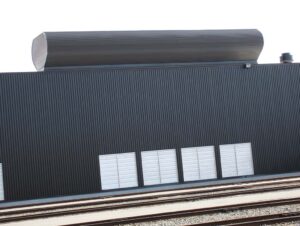
Industrial facilities demand reliable ventilation systems and controls to maintain safety and efficiency. Proper ventilation protects workers from hazardous fumes and creates a comfortable, productive environment. However, traditional powered ventilation systems can be a drain on both energy and budgets.
Gravity ventilators offer a potent alternative. These systems harness the natural power of air movement to deliver effective ventilation without the constant hum of fans and the resulting energy bills. Discover how gravity ventilators can support good airflow and temperature in your facility while helping to reduce overall operational costs.
Our expert team at Eldridge can partner with you to achieve superior industrial ventilation control. Schedule a consultation with us today.
Key Benefits of Gravity Ventilators
Gravity ventilators deliver a compelling list of advantages that directly impact your bottom line and your industrial environment. Foremost is cost savings. Unlike powered systems, they operate without consuming significant amounts of electricity. Maintenance needs are also minimal, further reducing operational expenses.
Air quality benefits are substantial. Gravity ventilators continuously remove stale air, fumes, pollutants, and excess moisture, creating a healthier and safer workspace. This also results in improved thermal comfort. By expelling trapped heat, temperatures are naturally lowered, increasing worker comfort and potentially eliminating the need for supplemental cooling in milder weather.
Industries Requiring High Industrial Ventilation Control
Manufacturing facilities particularly benefit from their ability to remove fumes, heat, and dust generated during production processes. This improves air quality and minimizes safety risks.
Warehouses and distribution centers, with their large open spaces, also find relief with gravity ventilation. Consistent airflow promotes a cooler environment and helps manage moisture, protecting stored goods.
Facilities like power plants and chemical plants, where safe removal of potentially hazardous gases is essential, can integrate gravity ventilators as part of their comprehensive ventilation strategy.
Ultimately, any industrial building contending with heat buildup, poor air quality, or excessive moisture will see improvements with a well-designed ventilation system incorporating gravity ventilators.
How Gravity Ventilators Work
Gravity ventilators exploit the basic principles of thermal buoyancy. When hot air rises, cooler and denser air naturally sinks to replace it. The ventilators are strategically installed on the rooftops of industrial buildings. Their design usually includes a series of vents, louvers, or dampers.
- Vents: These are openings in the gravity ventilator that allow air to pass through. They can be fixed or adjustable, depending on the specific design.
- Louvers: These are angled slats that control the direction and amount of airflow through the vents. They are typically angled downwards (from the inside to the outside) to prevent precipitation and debris from entering the building. The specific angle can be adjusted to optimize airflow while maximizing weather protection.
- Dampers: These are essentially adjustable valves installed within the vents or louvers. They offer a more precise way to regulate airflow through the gravity ventilator. They allow for precise control over the amount of airflow, optimizing ventilation for different seasons or operational needs.
As hot air and contaminants rise within the facility, they escape through these rooftop vents. This creates a subtle negative pressure, drawing in fresh, cooler air from lower levels of the building. The result is a continuous, self-sustaining cycle of airflow that requires no electricity to operate.
Optimizing Industrial Ventilation Control for Your Facility
Start by considering your building’s size and layout to determine the necessary ventilation capacity. Climate and prevailing weather patterns deserve close attention. For example, areas with consistent wind can better leverage gravity ventilation compared to locations with stiller air.
Additionally, consider how gravity ventilators may integrate with your existing ventilation system setup. They can often complement powered ventilation systems, providing base-level airflow while reducing the burden on fans and air conditioning.
Analyzing these factors will help you select the right type, size, and placement of gravity ventilators to fully reap their benefits.
Determining Your Building’s Heat Load
Selecting the ideal gravity ventilator requires understanding your specific needs. A crucial step is evaluating your building’s head load. Heat load refers to the total amount of heat energy that accumulates within a building. It’s calculated by considering all internal heat sources along with external factors like solar gain and ambient air temperature. Understanding heat load is essential for designing effective ventilation system control.
Assessing all sources of heat gain within your space is vital. These may include:
- Production Machinery: Equipment such as furnaces, ovens, kilns, boilers, motors, and other manufacturing processes can generate significant heat.
- Lighting: Industrial lighting fixtures often produce substantial waste heat.
- People: Human bodies naturally radiate heat, and a large workforce can contribute to a higher internal temperature.
- Computers and Electronic Equipment: Servers, control systems, motor starters, and other electronic devices generate heat during operation.
- Compressed Air Systems: Compressors and associated equipment can release heat into the environment.
- Solar Radiation: Sunlight entering through windows, skylights, and even walls can significantly heat the interior.
- Adjacent Processes: Heat generated in other areas of the building or neighboring facilities might transfer into the space.
Once you understand your heat load and sources, you can choose a gravity ventilator with the appropriate capacity to effectively remove trapped heat and maintain a comfortable, productive environment.
Invest in Efficient Industrial Ventilation Design and Control
Gravity ventilators offer industrial facilities a potent solution for enhanced ventilation, reduced costs, and a healthier, more sustainable workspace. Their efficiency and reliability make them an investment that pays dividends for years to come.
If you’re ready to explore the advantages of gravity ventilation for your operation, contact the industrial ventilation experts at Eldridge. We can design or retrofit a system tailored to your specific operational needs.
